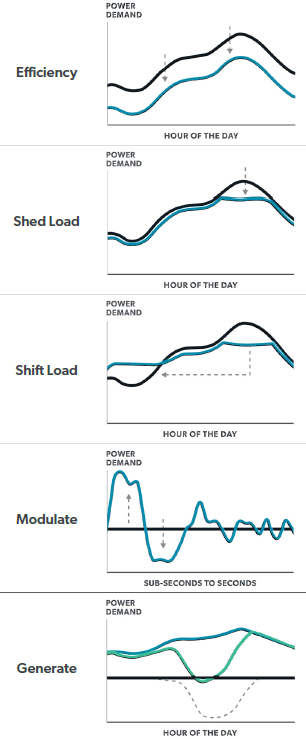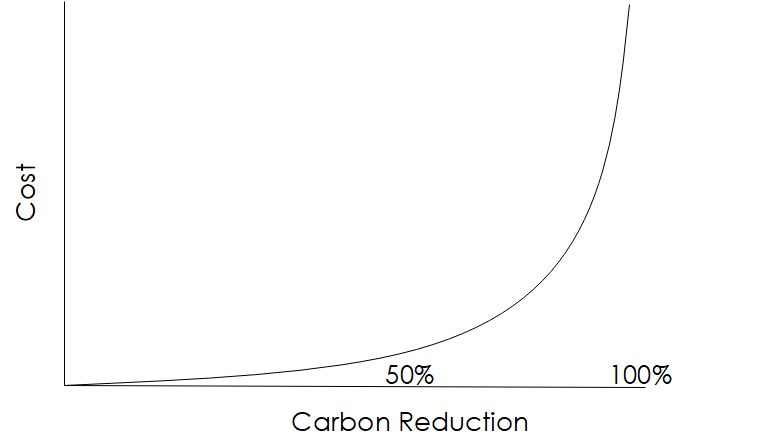
 To help accommodate intermittent renewable solar and wind power generation while minimizing grid and supply-side energy costs, the Department of Energy, its national labs, and our industry are exploring possibilities to use buildings as grid resources. The acronym de jour is GEBs, for grid-interactive, efficient buildings. What about the I? A focus group decided that gebs sounds better than giebs; therefore, GEBs[1].
To help accommodate intermittent renewable solar and wind power generation while minimizing grid and supply-side energy costs, the Department of Energy, its national labs, and our industry are exploring possibilities to use buildings as grid resources. The acronym de jour is GEBs, for grid-interactive, efficient buildings. What about the I? A focus group decided that gebs sounds better than giebs; therefore, GEBs[1].
Potential GEB benefits include:
- Accommodating large penetrations of renewable energy by shaping loads to take excess power when it is available for use when it is not available.
- Decarbonization.
- Energy conservation.
- Less-expensive energy supply.
- More customer control over energy costs.
What are some elements of GEBs? Pictures are worth thousands of words. The cartoon nearby was taken from the DOE’s National Roadmap for GEBs. It depicts the various ways buildings and the equipment in them can be used to change the net load of the building, and when aggregated together over hundreds or thousands of buildings, have a significant impact on the grid.
Efficiency
These charts are for demonstration, but efficiency resources have savings curves that depend on the weather, time of day, production levels, and many other possible factors. An energy efficiency measure or project rarely saves a constant load 24 hours a day. Energy saved concurrently with local or transmission-level peaks is worth far more, maybe infinitely more, than energy saved during the valleys of grid demand. Infinity is anything divided by zero, and if savings occur when renewables need to be curtailed, the energy and dollar savings are worth nothing.
Shedding
As shown in the cartoon, shedding can be something as simple as turning it off or down. Lighting is one example. Powered lighting curtailment saves lighting power, of course, but also interacting effects of air conditioning. Or, in the event of winter peaks, shutting down lights when it’s minus 15°F outside and heating is provided by air-source heat pumps, there may be no net impact because the energy burned by the lights heats the space and must be made up by the heating system. Here we are just beginning to see how complex this can be.
In other shedding events, say, air conditioner cycling, smart thermostat deployment, or commercial or industrial cooling curtailments, there will be some level of rebound or snapback. GEB deployment may be used to flatten a fast grid-scale ramp of demand, such as when the sun sets in a region with gobs of solar generation, but this may again provide no value from a greenhouse gas (GHG) perspective. It may save capital costs by avoiding or delaying peaking capacity, but it may merely shift natural-gas-fired power generation from here to there. So in some cases, GEBs may provide dollar savings, no GHG savings. Complex.
Shifting
Load shifting strategies include thermal or electrical storage. Last September 2020, I wrote a post on thermal energy storage here, which resulted in the development of a gruesomely detailed study and brilliant presentation posted here. The production of that video may have been the only time I’ve worn a button-down shirt since March 2020.
Beyond that, there is electrical storage in many forms, from batteries to kinetic (flywheels) to potential energy in pumped hydro, compressed air, and other technologies. In October 2020, I wrote at least a couple of posts on electricity storage, here and here. The challenge with many of these electricity storage technologies is they can increase GHG emissions due to losses in converting electricity to something and back to electricity. Again, there may be dollar savings but a negative GHG impact. Complex.
Modulate
Modulation is also known as shimmy. Some folks have called these families of load control strategies shape, shift, shave, and shimmy. Far out! While the roadmap describes batteries and inverters as ways to maintain voltage and frequency, a spinning reserve is a better, faster, and longer-lasting solution, in my opinion. The spinning reserve can be a flywheel, which can cycle up and down zillions of times over a 20-year lifetime or longer.
Generate
The roadmap uses solar photovoltaic as an example of generation. Why not standby generators, back pressure turbines, and other combined heat and power? These assets will not be forsaken to scrap heaps, a la cash for clunkers. We will need to use them at times. Reliable backup and reserves are critical to safe deep decarbonization.
Switch Fuel
You may notice that switching fuels from electricity to something pretty good from a GHG perspective, like natural gas for heating, is not part of the roadmap.
Hear me now and hear me loud: electrification purity will not happen in my lifetime – let’s just call it 2050, when all the zero-carbon promises will be broken. For one thing, everyone is promising net-zero carbon. That isn’t even close to zero carbon. All that means is organizations or people are vowing to produce as much zero-carbon energy as they consume. It also means that they are exporting their GHG emissions for many hours of the year while they HAVE TO buy from a conventional thermal power plant.
See my cartoon below for the cost v carbon abatement level. There are cheaper ways to do it, like efficiency and GEBs, and there are expensive ways to do it with batteries made from rare earths controlled by tyrannical criminal regimes. Keep it here. Brains made in America!
 Next week, following this introductory post, I’m going to dive into a throng of other issues that need to be addressed in the quest for GEBs – a lot of wood to chop!
Next week, following this introductory post, I’m going to dive into a throng of other issues that need to be addressed in the quest for GEBs – a lot of wood to chop!
[1] This is a blog, so things may or may not be true.





